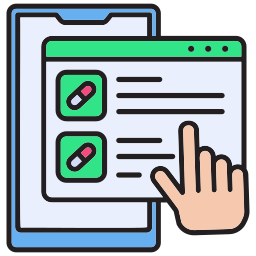Feeling overwhelmed by your upcoming Epic implementation? Many healthcare organizations encounter significant challenges when deploying an Epic EHR system. From managing workflow disruptions to achieving smooth user adoption, the process can be complex. An effective Epic implementation, however, can transform these challenges into opportunities, boosting care delivery and operational efficiency.
Epic, a leading EHR system, is integral to modern healthcare, with over 250 million patients' electronic records. Its integration enhances clinical workflows, patient care, and operational efficiency. Despite the complexity of Epic EMR integration, following these seven proven steps will help your organization navigate the process successfully, ensuring a smoother transition and optimizing the benefits of Epic EHR integration.

Step 1: Define Your Vision and Goals (Pre-Implementation)
Setting clear objectives and involving key stakeholders from the start are vital for ensuring a successful Epic implementation.
1️⃣ Set SMART Goals
Define Specific, Measurable, Achievable, Relevant, and Time-bound goals before starting your Epic implementation. These goals will direct the project, ensuring each phase aligns with overall objectives, improving clinical workflows, enhancing patient care, and increasing operational efficiency through Epic EHR integration.
2️⃣ Involve Key Stakeholders
Early engagement of clinicians, administrators, and IT staff is vital. Their insights into current workflows are crucial for understanding how Epic can improve processes. This collaboration is key to creating a targeted Epic EMR integration plan that addresses specific pain points and integrates effectively with existing systems.
3️⃣ Create a Collaborative Approach
Engaging key stakeholders and addressing their unique needs ensures that the Epic system is designed to meet your organization’s specific requirements. This approach supports the project’s focus, facilitates smoother Epic EHR integration, and ensures that the system is well-suited to the unique needs of your healthcare setting.
By identifying and addressing specific pain points, you can create a more precise implementation plan aligning with your organization’s needs. This collaborative approach promotes buy-in and ensures that the system is designed to support the unique requirements of your healthcare setting.
Step 2: Assess Your Resources (Pre-Implementation)
Evaluate your existing IT infrastructure and data compatibility to ensure a smooth Epic EHR integration. Proper resource assessment helps prevent delays and supports a successful Epic EMR integration.
🏗️ Evaluate IT Infrastructure
Begin by thoroughly examining your existing IT infrastructure. Determine if any upgrades are necessary to support Epic’s advanced features. Addressing these requirements early helps avoid any delays and ensures a smoother Epic implementation process.
📃 Inventory and Assess Data
Conduct a detailed inventory of your current data, assessing its compatibility with Epic’s formats. Identify any gaps or issues that may need to be resolved. Ensuring that your data is clean and well-structured is essential for a smooth transition and maintaining the integrity of patient information during Epic EHR integration.
👷♂️ Determine Staffing Requirements
Identify the staffing needs for training and ongoing support. Epic implementation is complex, and having the right team is critical. Assess the number of staff members required for the initial rollout and long-term support, including the training of clinicians, administrators, and IT personnel. Proper preparation helps minimize workflow disruptions and encourages successful Epic EMR integration.
Step 3: System Design and Configuration (Pre-Implementation)
Collaborate with Epic experts to customize the system for your organization’s needs. Proper design and configuration ensure that workflows are optimized for efficiency and usability.
🤝 Collaborate with Epic Specialists
Work closely with Epic integration experts like HealthConnect CoPilot, who process FHIR compliance data and have deep knowledge of the system's capabilities. This collaboration ensures the Epic implementation is customized to fit your healthcare facility’s needs. By aligning the setup with existing workflows, you optimize efficiency across all departments and meet your organization’s unique requirements.
🧑💻 Develop a Data Conversion Plan
Create a detailed plan for migrating existing records into the Epic system. Accurate data conversion is essential to prevent data loss and maintain the integrity of patient records. Proper planning ensures a smooth data transition, crucial for maintaining continuous patient care during the Epic EHR integration.
🦾 Configure Workflows and User Interfaces
Adjust workflows and user interfaces to meet the needs of each department. Understand how various teams use the system daily and configure it to support their tasks. By incorporating industry best practices and insights from your organization’s experiences, you establish an intuitive system that supports efficient operations, laying the groundwork for a user-friendly Epic EMR integration.
Step 4: Build and Test (Implementation)
Develop integrations that connect Epic with your existing systems. Conduct thorough testing with end-users to identify and resolve issues before the system goes live.
✅ Develop Customized Integrations
In the build phase of your Epic implementation, prioritize creating custom integrations that align with your existing healthcare IT systems. This includes linking Epic with laboratory information systems, billing platforms, and other essential software. Ensuring smooth data exchange across these platforms is crucial for maintaining information flow and supporting clinical and administrative functions. Properly executed integrations are vital for a successful Epic EHR integration and smooth operation after implementation.
✅ Conduct User Acceptance Testing (UAT)
Engage a diverse group of staff from different departments in User Acceptance Testing (UAT). Involving clinicians, administrative staff, and other end-users in testing ensures the system meets practical needs across all departments. This hands-on approach helps identify potential issues that may not be apparent during the build phase, allowing for timely corrections. UAT is essential for confirming that the Epic EMR integration is ready for real-world application.
✅ Refine System Configurations
After completing UAT, refine the system configurations based on feedback. Address any issues identified to prevent disruptions during the Epic implementation go-live. This iterative testing and adjustment process ensures the Epic system operates effectively and integrates smoothly into daily workflows. Taking these steps helps ensure a successful and user-friendly Epic EHR integration.
Step 5: Training and Go-Live (Implementation)
Create a training program tailored to all staff levels. Ensure a smooth transition by providing clear communication and support during the go-live phase.
➡️ Develop a Thorough Training Program
Successful Epic implementation relies heavily on effective training. Create a program designed for all levels of staff within your organization, including clinicians, administrative personnel, and IT staff. Each group should receive training specific to their roles to ensure they can navigate the system efficiently from day one. A well-structured training program ensures that everyone can use the Epic system effectively and confidently.
➡️ Offer Various Training Formats
To meet diverse learning needs and schedules, provide multiple training options. In-person sessions offer hands-on experience, while online and on-demand formats allow the flexibility to learn at their convenience. This variety ensures all employees have access to the training that suits their preferences, helping them become proficient with the Epic EHR system.
➡️ Coordinate a Smooth Go-Live Transition
Proper coordination is essential for launching the Epic EMR system. Communicate clearly with all staff about the transition schedule, what to expect, and where to find support. Establish dedicated support channels to quickly address any issues, minimize disruptions, and assist staff in adapting to the new system. This planning helps ensure a smoother transition and supports the effective use of the Epic EHR Integration.
Step 6: Post-Go-Live Support and Optimization
Offer ongoing support to address any user issues. Regularly monitor system performance to identify areas for improvement and ensure continued efficiency.
👀 Provide Ongoing Support
The success of an Epic implementation relies on continuous support after the go-live phase. Establish a dedicated support team to assist users in navigating the Epic EHR integration and resolving any issues. Timely resolution of questions and problems is essential for minimizing frustration and ensuring smooth operations with the Epic EMR Integration.
👀 Monitor System Performance
Consistent monitoring of the Epic system's performance is crucial to identify areas for improvement. Regularly assess the system’s functions and look for any inefficiencies or user difficulties. This ongoing evaluation allows for necessary adjustments, ensuring the Epic Implementation effectively meets the organization’s needs.
👀 Gather User Feedback
Collecting feedback from users who engage with the Epic system daily offers valuable insights for ongoing improvements. Understanding their experiences and challenges enables informed decisions on adjustments or upgrades. This method optimizes the system and promotes a collaborative environment, contributing to better outcomes for both staff and patients.
👀 Sherlock Ticket
For any integration-related queries, such as HL7 or FHIR endpoint issues, vendors should raise a Sherlock ticket via their Vendor Services account. To create a ticket, log in; you can navigate to the "Jump To" tab, and select "Sherlock." Now, clearly define the use case and product workflow for EPIC's understanding. For FHIR integration, identify required endpoints, distinguishing between public and private ones. If private API access is needed, submit an Interoperability Request Form, providing detailed workflow information and a customer contact reference. Always include the Sherlock ticket number if applicable.
Step 7: Long-Term Strategy and User Adoption (Ongoing)
Focus on maintaining the system through regular updates. Promote user engagement by sharing success stories and gathering feedback for continuous improvement.
⚙️ Develop a Maintenance Plan
To ensure the long-term success of your Epic implementation, it's crucial to create a maintenance plan that includes regular updates and checks. Keeping Epic EHR integration aligned with the latest technological advancements and the evolving needs of your organization is vital. This proactive approach helps maintain the system’s effectiveness and relevance over time.
📈 Promote User Engagement
Sustaining the success of the Epic EMR Integration involves actively engaging users by sharing success stories and demonstrating the system’s benefits. Offering ongoing training sessions helps. Staff can stay up-to-date with new features and sharpen their skills. This continued support encourages users to fully utilize the Epic system’s capabilities.
🔁 Establish a Feedback Loop
Implement a structured feedback process to improve the system continuously. Regularly gather insights from users to identify areas needing refinement or additional training. Addressing this feedback ensures that the Epic implementation remains effective and aligned with your organization's goals, ultimately supporting high-quality patient care.
How HealthConnect CoPilot Helps with Epic Integration?
HealthConnect CoPilot addresses data silos by securely sharing healthcare data between different applications. During Epic EHR integration, we simplify data exchange, which supports a smoother transition and improves system compatibility.
Integrated with Epic, HealthConnect CoPilot ensures that crucial healthcare data flows efficiently between systems without interruption. This feature is especially valuable for Epic implementation, as it helps maintain consistent data exchange, minimizes the risk of errors, and ensures uninterrupted patient care.
HealthConnect CoPilot’s compatibility with existing systems contributes to a smoother transition and more reliable operations throughout the Epic EMR integration process.
- What are the essential steps for a successful Epic implementation?
Successful Epic implementation involves several crucial steps: defining clear objectives, engaging stakeholders early, selecting a capable project team, developing a detailed project plan, ensuring thorough training, testing the system extensively, and planning for ongoing support.
- How can we ensure that stakeholders are effectively involved in the Epic implementation process?
Involving stakeholders early in the process is essential. Start by identifying all relevant parties and keeping them informed through regular updates and consultations. Their input will help align the project with organizational needs and facilitate smoother adoption.
- What are common challenges during Epic implementation, and how can they be addressed?
Common challenges include resistance to change, data migration issues, and system integration complexities. Address these by providing adequate training, performing thorough testing, and maintaining open lines of communication with all stakeholders.
- Why is training important in Epic implementation, and how should it be approached?
Training is crucial for ensuring that users understand how to effectively use the new system. Approach training by developing a structured program that includes hands-on practice, user guides, and ongoing support to help users adapt to the system.
- How can we measure the success of our Epic implementation?
Success can be measured by evaluating whether the project meets its predefined objectives, assessing user satisfaction, monitoring system performance, and reviewing the impact on workflow efficiency and patient care. Regular feedback and performance metrics will provide insight into the implementation’s success.

Pravin Uttarwar, CTO of Mindbowser
As the CTO of Mindbowser, a healthcare-focused software development company, I am dedicated to delivering cutting-edge digital solutions that transform patient care and operational efficiency. With over 16 years of experience and as an MIT alumnus, I specialize in healthcare interoperability, FHIR-compliant systems, and AI-powered platforms, crafting scalable products and architectures tailored to the unique needs of healthcare providers and enterprises.
I have spearheaded the development of over 100 products and platforms, guiding them from concept to full-fledged solutions. My expertise extends to scaling remote tech teams, driving EHR integrations, and building secure, cloud-native healthcare solutions. By shaping technology visions and roadmaps, I help clients achieve long-term growth and success in the rapidly evolving healthcare landscape.
HealthConnect CoPilot enabled us to access real-time patient health data through integration with Apple HealthKit, enhancing care delivery while maintaining HIPAA compliance. This led to personalized care and improved outcomes for patients.

AI-enhanced Obstetrics Clinical Decision Support Platform
HealthConnect CoPilot's integration with Epic's Hyperspace has transformed our workflow. Automated post-delivery examinations and HL7 protocol use ensure accurate updates to Epic. Their expertise empowers informed decision-making in childbirth

Top Provider for Customized Healthcare Solutions
HealthConnect CoPilot's helped us to integrate with leading tracking devices such as Apple Watches and Fitbit. This integration enables effortless syncing of health data, providing users with real-time insights displayed directly on our flagship products: smart mirrors and digital calendars.

A Provider of Customizable Display Solutions
Post a comment Cancel reply
Related Posts
EHR Integration for Solo Practices: A Complete Step-by-Step Guide
Still running your solo practice on sticky notes and spreadsheets? It’s time for an upgrade.…
Epic Wisdom Explained: Features, Benefits, and Why It’s the Future of Dental EHR
Dental care has traditionally existed in its bubble, separate from the hospital EHRs, invisible to…
FHIR Versions: The Past, The Present & The Future
The Fast Healthcare Interoperability Resources (FHIR) standard has revolutionized healthcare data exchange, enabling seamless interoperability…
What Are CDS Hooks? A Simple Guide for Healthcare Providers
CDS Hooks are changing how clinical decision support (CDS) works inside EHRs, bringing real-time, context-aware…
The Challenges and Benefits of EHR Integration for Health Tech Companies
As digital health companies continue to innovate and develop cutting-edge healthcare solutions, one of the…
Streamlining Behavioral Healthcare with Epic EHR Integration
Behavioral healthcare providers are facing an increasing demand for streamlined systems that can integrate multiple…









